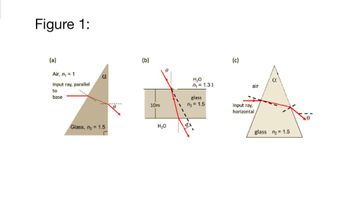.. Here, the triangle is isosceles, and alpha (the angle at the top of the triangular prism) is 61.1 degrees. What is theta (the angle below the horizontal that the ray makes emerging from the prism on the right)? 16.2 degrees 8.1 degrees 21.1 degrees 9.7 degrees Figure 1: (a) Air, n₁ = 1 Input ray, parallel to base α Glass, n₂ = 1.5 (b) 10m H₂O H₂O n₁ = 1.33 glass ₂=1.5 (c) air Input ray, horizontal C glass n₂ = 1.5
.. Here, the triangle is isosceles, and alpha (the angle at the top of the triangular prism) is 61.1 degrees. What is theta (the angle below the horizontal that the ray makes emerging from the prism on the right)? 16.2 degrees 8.1 degrees 21.1 degrees 9.7 degrees Figure 1: (a) Air, n₁ = 1 Input ray, parallel to base α Glass, n₂ = 1.5 (b) 10m H₂O H₂O n₁ = 1.33 glass ₂=1.5 (c) air Input ray, horizontal C glass n₂ = 1.5
Oh no! Our experts couldn't answer your question.
Don't worry! We won't leave you hanging. Plus, we're giving you back one question for the inconvenience.
Submit your question and receive a step-by-step explanation from our experts in as fast as 30 minutes.
You have no more questions left.
Message from our expert:
Our experts need more information to provide you with a solution.Please provide with the incident angle of the input ray .Please resubmit your question, making sure it's detailed and complete. We've credited a question to your account.
Your Question:
Refer to c

Transcribed Image Text:.. Here, the
triangle is isosceles, and alpha (the
angle at the top of the triangular
prism) is 61.1 degrees. What is theta
(the angle below the horizontal that
the ray makes emerging from the
prism on the right)?
16.2 degrees
8.1 degrees
21.1 degrees
9.7 degrees

Transcribed Image Text:Figure 1:
(a)
Air, n₁ = 1
Input ray, parallel
to
base
α
Glass, n₂ = 1.5
(b)
10m
H₂O
H₂O
n₁ = 1.33
glass
₂=1.5
(c)
air
Input ray,
horizontal
C
glass n₂ = 1.5
